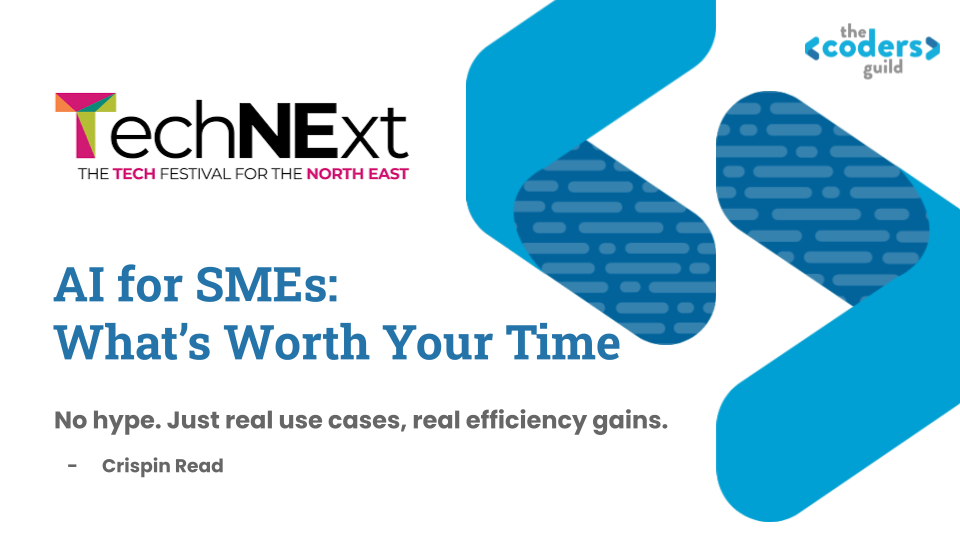
AI Adoption Doesn't Need a Strategy It Needs a First Step

4 mins read
By Crispin Read - 23rd Oct 2025
You're overthinking this.
While you plan the perfect AI strategy, your competitors are building their third small helper.
Forty-two percent of UK SMEs have no plans to implement AI tools in the next year. Another 21% reckon AI has no applicability to their operations.
That's not a skills problem. That's a starting problem.
The pattern is consistent. Business owners know AI could help. They've read the articles. They've seen the demos. They've watched competitors move faster.
But they're not moving.
The Real Barrier Is Overwhelm
Here's what's actually happening. SME leaders are stretched across operations, finance, people, growth. They're already managing more than they should.
Then AI shows up as this massive thing they need to "do."
They file it under "big project we don't have time for." The mental load alone is enough to push it down the priority list. And once it's down there, it stays down there.
Meanwhile, the productivity gap widens. Research from the University of St Andrews shows SMEs adopting AI see productivity gains between 27% and 133%. That's not marginal. That's transformative.
But you can't access those gains if you never start.
The Compounding Effect Nobody Mentions
AI adoption isn't like other technology shifts. It compounds.
The businesses that start early don't just get a head start. They build practice. They embed AI into daily operations. They learn what works through iteration, not theory.
Every week you wait, they get better. Not because they're smarter or better funded. Because they're doing it.
The gap isn't about capability. It's about momentum.
Couch to 5K for AI
Stop thinking about AI as a transformation project. Start thinking about it like training for a 5K.
You don't need a complete strategy. You don't need to hire specialists. You don't need to overhaul everything.
You need to take a twenty-minute demo and build one small AI helper.
Maybe it's a custom GPT that writes in your brand voice. Maybe it's a tool that helps create standard operating procedures. Maybe it's something that crunches data you've been manually processing.
The specifics don't matter. What matters is starting.
Because once you've built one small helper, you've crossed a threshold. You're no longer someone who "should look into AI." You're someone who uses AI. That shift changes everything.
That's exactly what we're doing with our ‘QuickBytes’ series at The Coders Guild. Over the coming weeks and months, we're sharing small, practical things you can do straight away. Twenty-minute demos that show you how to build specific AI helpers for your business.
Custom GPTs that write in your brand voice. Tools that help create standard operating procedures. Simple automations for data you've been manually processing.
These aren't theoretical webinars. They're hands-on sessions where you follow along and build something you can use immediately.
Follow The Coders Guild to catch these ‘QuickBytes’ sessions. Each one is a single step forward. Each one makes the next step visible.
Leaders Don't Need to Know Everything
Here's what trips people up. They think they need to become AI experts before they can implement anything.
You don't.
Leaders need baseline knowledge. Enough to recognise opportunities. Enough to ask the right questions. Enough to make informed decisions about where to invest time and resources.
The detailed implementation? That can be delegated. Your team can take projects forward once you've created the permission structure.
But you need to know something. And the only way to know something is to do something.
You Can See Where to Put Your Next Foot
There's an old fable about someone lost in a dense, dark wood. They can't see the path out. They can't see where they're going.
But they can see where to put their next foot.
So they take that step. And from there, they can see the next one.
That's AI adoption for most SMEs right now. You don't need to see the entire path. You just need to see the next step clearly enough to take it.
The behavioural barriers to technology adoption aren't about capability. They're about anxiety over change, overconfidence in the status quo, and choice paralysis.
All of those dissolve once you take the first step.
The Cost of Not Starting
Every day you don't start is a day your competitors get better at this. Every week is another cycle of practice they've embedded. Every month is more productivity gains you're leaving on the table.
The businesses that will struggle aren't the ones using AI badly. They're the ones still deciding whether to start.
If you're lost in the woods, standing still doesn't help. Moving in any direction at least gives you new information.
Find your twenty-minute demo. Build your first small helper. Take the next visible step.
Because if you don't start, you can't stop either.
The gap between you and your competitors widens every day. But it narrows the moment you start.




